My name is Jessica Orcutt, and I am an assistant teacher for the wonderful children’s art camp that the Gibbes hosts each summer. I am a junior at Skidmore College in Saratoga Springs, New York. Though my school is over a thousand miles away, I will always be thankful that I spent most of my childhood in Charleston. My years in this beautiful city have given me a deep appreciation for its impressive historical and artistic heritage, and it has been my pleasure this summer to introduce our next generation to Charleston’s creative traditions.
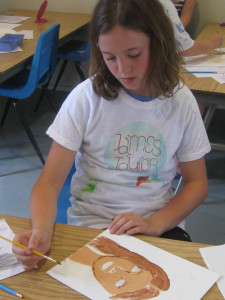
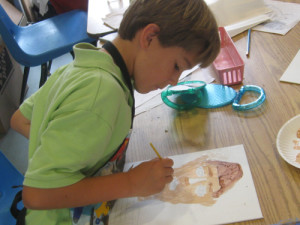
I am a History major, but I have always enjoyed creating and studying art. Interning with the museum’s Education and Outreach department has allowed me to learn more about art right alongside my campers. In the first camp session, the children learned about many different ancient civilizations— we painted our names in Egyptian hieroglyphics, created rustic cave paintings, constructed fantastical African masks, pieced together Roman mosaics, and sewed Native American medicine pouches. Every day before we began our art projects, the children would sit together on the rug and learn about a particular civilization. Perhaps the best moment of this camp was when, after studying ancient Roman mosaics, the campers discovered present-day mosaics all around them, from the floor of the entrance into the Gibbes, all the way to the dome crowning the top of the museum. I greatly enjoyed laying down on the carpet of the Rotunda Gallery of the museum with the campers, and staring up into the green stained-glass dome. The kids were one hundred percent positive that it was made to look like the eye of a dragon; that the entire building made up the creature’s body; and that we were currently lying in the dragon’s belly.

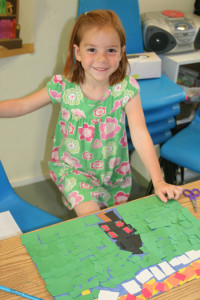
The second camp session was called “Go Green,” and was centered around teaching the kids about the importance of recycling and protecting our environment. We created all of our art projects in this camp purely out of recycled materials. Both the younger and older age groups greatly enjoyed tie-dying shirts, creating magazine collages, and putting together sculptures made from discarded objects. Many of the older campers made impressive and imaginative sculptures, such as a surfing scene, rockets, and a positively adorable giraffe. The younger campers, aged between four and seven, had the opportunity to make instruments from recycled materials— it was obvious that they greatly enjoyed this project. They proceeded to create an instrumental band and give us teachers a wonderful concert in the recess area!
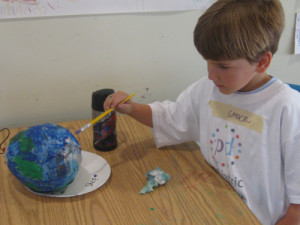
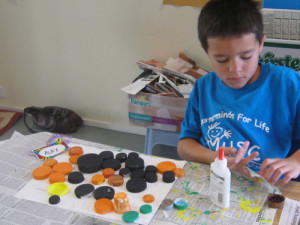
The third session, called “Charleston’s Gardens and Wildlife,” is perhaps the most popular of all three camps. Both weeks are completely full, and there is a waiting list a mile long! But I am so glad that children and their parents find interest and joy in Charleston’s natural beauty. In this camp, we will be learning about and drawing examples of the Lowcountry’s native flora and fauna. We will also be visiting several local gardens so that we may sketch and paint in a pleasant outdoor environment. The campers will also be taking home personal terrariums. We will focus on one particular temporary exhibition in the museum, Places for the Spirit: Traditional African American Gardens of the South. The black-and-white photographs that make up this exhibit are truly beautiful, and though I have seen them several times (we take each group of campers to the museum every Friday), the wonder and mystery of the photographs never fail to touch me. Truly, if you have not yet had the chance to visit either this exhibit or Mary Whyte’s watercolor masterpieces, please consider doing so. Such art should not be missed, and I am so glad the children who participated in each of these camps have had the opportunity to experience such beautiful creations.
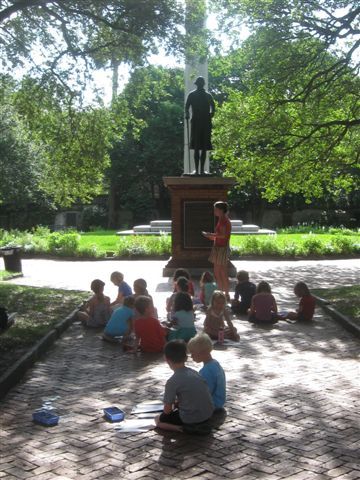
The museum provides the next generation with an invaluable opportunity to discover Charleston’s artistic history, and also provides them with a more modern view of the world they live in. From what I have gathered in talking with campers’ parents, the kids have truly enjoyed creating personal masterpieces. I feel truly blessed to have been given this opportunity to work with such wonderful and enthusiastic young artists over these past several weeks.
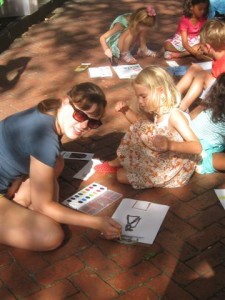
—Jessica Orcutt, Gibbes summer intern and guest blogger
Published July 11, 2012

